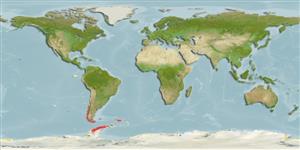Common names from other countries
Environment: milieu / climate zone / depth range / distribution range
Ecologia
; intervalo de profundidade 10 - 610 m (Ref. 87801). Polar; 46°S - 74°S, 77°W - 35°W
Southeast Pacific and Antarctic Atlantic.
Length at first maturity / Tamanho / Peso / Idade
Maturity: Lm ? range ? - ? cm
This is a benthic mobile species found on primnoid gorgonians at depths of 10 to 610 m. It has a mouth capable of opening very wide, allowing it to prey on octocorals (Ref. 87801). Solitary (Ref. 2377).
Life cycle and mating behavior
Maturidade | Reprodução | Desova | Ovos | Fecundidade | Larvas
Members of the class Anthozoa are either gonochoric or hermaphroditic. Mature gametes are shed into the coelenteron and spawned through the mouth. Life cycle: The zygote develops into a planktonic planula larva. Metamorphosis begins with early morphogenesis of tentacles, septa and pharynx before larval settlement on the aboral end.
Southern Ocean Mollusc Database (SOMBASE). 2011. (Ref. 87340)
Categoria na Lista Vermelha da IUCN (Ref. 130435)
Categoria CITES (Ref. 108899)
Not Evaluated
Not Evaluated
Utilização humana
| FishSource |
Ferramentas
Mais informação
Idade/Tamanho
Crescimento
Comprimento-peso
Comprimento-comprimento
Morfologia
Larvas
Abundância
Fontes da internet
Estimates based on models
Preferred temperature
(Ref.
115969): 0.5 - 9.8, mean 7.1 (based on 46 cells).
Categoria de preço
Unknown.
